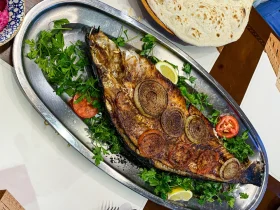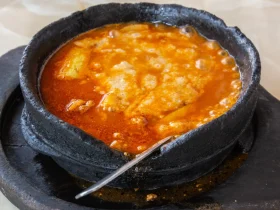Imagine sipping on a velvety cup of coffee that transports you to the vibrant streets of Istanbul, where centuries-old traditions blend seamlessly with modern life. Turkish coffee, a true gem of the coffee world, has been enchanting palates for generations. In this guide, we’ll delve into the captivating process of making Turkish coffee from scratch, uncovering its history, cultural significance, and the secrets to brewing the perfect cup. So grab your cezve and let’s embark on a journey through the rich and aromatic world of Turkish coffee.
[ez-toc]
History
The story of Turkish coffee is a captivating journey through time, culture, and innovation. Its origins are shrouded in mystique, spanning centuries and continents, ultimately giving rise to a brew that’s more than just a beverage – it’s an emblem of tradition and connection.
Ancient Beginnings
The tale of Turkish coffee begins in the mystic lands of Ethiopia, where legend has it that a goat herder named Kaldi stumbled upon the invigorating effects of coffee beans. Intrigued by the energy it bestowed upon his goats, Kaldi shared his discovery with a local monastery. The monks experimented with the beans, creating a stimulating concoction that aided them in staying awake during long hours of prayer and devotion.
A Journey to the East
From Ethiopia, coffee traveled to the Arabian Peninsula, where it became an integral part of Islamic culture. The vibrant markets of Yemen were adorned with coffee stalls, and the brew gained popularity for its ability to bring people together. It wasn’t merely a drink; it was a medium for conversation and companionship.
The Birth of Turkish Coffee
The vibrant tapestry of coffee’s journey eventually led it to the bustling city of Istanbul in the early 16th century. The Ottoman Empire embraced this elixir, and its transformation into Turkish coffee began. The beverage quickly became a symbol of hospitality and friendship, with the first coffeehouses, known as “qahveh khaneh,” sprouting up across the city.
The Art of Brewing
Turkish coffee wasn’t just a drink; it was a performance. Skilled coffee makers, or “kahvecis,” turned the brewing process into an art form. The iconic cezve, a long-handled pot, made its appearance, becoming an essential tool in the preparation of this aromatic elixir. As the Ottomans expanded their empire, so did the popularity of Turkish coffee, spreading its influence across cultures and continents.
Cultural Significance
In the Ottoman Empire, coffeehouses became hubs of intellectual exchange. Scholars, artists, and thinkers gathered to share ideas, debate philosophy, and engage in spirited discussions. Coffeehouses were more than places to enjoy a cup of coffee; they were centers of cultural enrichment, creativity, and camaraderie.
A Symbol of Tradition
The rich cultural significance of Turkish coffee is further exemplified by the inclusion of the brew in pivotal life events. From marriage proposals to celebrations, Turkish coffee played a role in ceremonies that marked important milestones. The traditional “tasseography,” or fortune-telling using coffee grounds, added an element of mysticism to the experience, deepening its connection to tradition.
Modern Resurgence
As time marched forward, Turkish coffee faced competition from newer brewing methods and coffee trends. However, its legacy endured, cherished by those who appreciated its rich history and unique preparation process. In recent years, there has been a resurgence of interest in traditional methods of brewing, and Turkish coffee has found a new generation of enthusiasts eager to savor its deep flavors and cultural significance.
Preserving the Legacy
Today, Turkish coffee stands as a testament to the power of tradition and the enduring appeal of a well-crafted cup of coffee. Its history is a tapestry woven with stories of discovery, innovation, and the profound impact of a simple beverage on the fabric of societies. As we take a sip of this enchanting brew, we’re not just tasting coffee; we’re savoring the essence of centuries past, a legacy that continues to captivate and connect people around the world.
Time
| Step | Time |
|---|---|
| Grinding coffee beans | 5 minutes |
| Setting up the cezve and water | 2 minutes |
| Mixing coffee, water, and sugar in the cezve | 3 minutes |
| Brewing coffee over low heat | 10 minutes |
| Adding cardamom and spices | 1 minute |
| Frothing and stirring (optional) | 1 minute |
| Allowing the brew to settle | 2 minutes |
| Pouring into cups and serving | 1 minute |
| Savoring each sip | Timeless |
Remember, while the individual steps may take a specific amount of time, the overall experience of making and enjoying Turkish coffee is a delightful journey that encourages slowing down and savoring each moment.
Ingredients
| Ingredients | Quantity |
|---|---|
| Fresh Coffee Beans | 4 tablespoons |
| Cold Water | 1 cup |
| Sugar (optional) | 2 teaspoons |
| Ground Cardamom | 1/4 teaspoon |
Directions
Step 1: Grinding the Coffee Beans
- Begin by grinding 4 tablespoons of fresh coffee beans to an extra-fine consistency, resembling powdered sugar.
Step 2: Setting Up the Cezve and Water
- Fill the cezve with 1 cup of cold water.
- If desired, add 2 teaspoons of sugar to the water for sweetness.
Step 3: Mixing Coffee, Water, and Sugar in the Cezve
- Gently stir the water to dissolve the sugar.
- Add the finely ground coffee to the cezve.
Step 4: Brewing Coffee over Low Heat
- Place the cezve on the stovetop over low heat.
- Allow the coffee mixture to slowly heat up, but avoid bringing it to a boil.
- As the coffee heats, you’ll notice a foam forming on the surface.
Step 5: Adding Cardamom and Spices
- If desired, sprinkle 1/4 teaspoon of ground cardamom into the cezve for a fragrant and traditional touch.
Step 6: Frothing and Stirring (Optional)
- As the coffee begins to heat and foam, you can choose to gently stir the foam or leave it intact, depending on your preference.
- Stirring can help distribute flavors, while leaving the foam untouched creates a creamy crown.
Step 7: Allowing the Brew to Settle
- Once the coffee is heated and the foam has formed, remove the cezve from the heat source.
- Allow the coffee grounds to settle at the bottom of the cezve for a few moments.
Step 8: Pouring into Cups and Serving
- With a steady hand, pour the brewed coffee into small cups, distributing the foam evenly.
- Leave a bit of space at the top of each cup to accommodate the coffee grounds.
Step 9: Savoring Each Sip
- Turkish coffee is meant to be enjoyed slowly, allowing the rich flavors to unfold on your palate.
- Take your time to savor the intensity of the brew, appreciating the depth of its character.
Each step in the process contributes to the art of Turkish coffee, culminating in a cup of history, tradition, and sensory delight. Embrace the ritual and share this enchanting experience with friends and loved ones.
Equipment Required
Nutrition Information
| Nutrition Information | Per Serving |
|---|---|
| Serving Size | 1 cup |
| Calories | 2 |
| Total Fat | 0g |
| Saturated Fat | 0g |
| Trans Fat | 0g |
| Cholesterol | 0mg |
| Sodium | 1mg |
| Total Carbohydrates | 0g |
| Dietary Fiber | 0g |
| Sugars | 0g |
| Protein | 0.2g |
| Vitamin D | 0% |
| Calcium | 0% |
| Iron | 0% |
| Potassium | 0% |
Please note that Turkish coffee is virtually calorie-free, as it is a plain beverage without significant macronutrients. This nutritional information is approximate and can vary based on factors such as the type of coffee beans used and any optional additions like sugar.
Tips
- Choose High-Quality Beans: Opt for fresh, high-quality coffee beans. A medium to dark roast is ideal for Turkish coffee, as it imparts rich flavors and a satisfying depth.
- Mind the Grind: The key to a velvety cup lies in the grind. Ensure your coffee beans are ground to an extra-fine consistency, similar to powdered sugar.
- The Cezve Matters: Invest in a good-quality cezve. A copper cezve conducts heat evenly and contributes to the coffee’s unique flavors.
- Water Ratio: Experiment with the coffee-to-water ratio to find your preferred balance of strength and flavor. Start with a 1:10 ratio and adjust to taste.
- Low and Slow: Brew the coffee over low heat to avoid boiling. This gradual process extracts flavors without scalding the brew.
- Master the Froth: While traditionalists keep the foam intact, a gentle stir won’t hurt. Personalize your brew by choosing your frothing style.
- Cardamom Infusion: Add a pinch of ground cardamom for an authentic touch. Adjust the amount based on your taste preferences.
- Watch the Sediment: Turkish coffee has a bit of sediment at the bottom. It’s perfectly normal and adds to the experience. Just be mindful when taking that last sip.
- Serve with Delight: Presentation matters. Pour the coffee with finesse, ensuring each cup receives a fair share of foam.
- Pairing Perfection: Consider pairing Turkish coffee with traditional sweets like baklava or delightfully contrasting with savory snacks like pistachios.
Pros & Cons
| Pros | Cons |
|---|---|
| ✅ Rich, Aromatic Flavor | ❌ Requires Special Equipment |
| ✅ Cultural and Historical Significance | ❌ Time-Intensive Process |
| ✅ Intimate and Ritualistic Brewing | ❌ Strong, Intense Flavor |
| ✅ Minimal Calories and Low in Fat | ❌ Sediment at the Bottom of the Cup |
| ✅ Customizable with Spices and Variations | ❌ Acquired Taste for Some |
Conclusion
In a world where coffee has become a quick fix, Turkish coffee stands as a reminder of the magic that unfolds when tradition, culture, and flavor unite. Each step in the brewing process is a tribute to history, a nod to the art of conversation, and an invitation to savor the moment.
From the meticulous grind to the patient simmer, each action is a brushstroke on the canvas of an ancient ritual. The result? A cup of liquid poetry that carries the essence of centuries past, a blend of aromas and stories that linger on your palate.
As you take that first sip, you’re not just tasting coffee; you’re sipping on tales woven into the fabric of a culture. The rich flavors, the delicate foam, and the inviting aroma are an homage to the hands that have passed down this tradition through generations.
So, why not embark on this sensory journey? Experience the thrill of mastering the cezve, the joy of pouring with finesse, and the delight of sipping slowly. Let the history, the art, and the magic of Turkish coffee infuse your every sip, and transport you to a world where each cup is an invitation to connect, converse, and create memories.
Unlock the secrets of this timeless brew and create your own story. Whether shared with friends or enjoyed in solitude, Turkish coffee promises an experience that transcends time and flavors. Embrace the enchantment, and with each sip, celebrate the confluence of tradition and taste.
Facts
- Fact 1: ☕ The Coffee That Saved a Revolution
- Did you know that Turkish coffee played a role in thwarting a political coup? During the Ottoman Empire, a grand vizier discovered a conspiracy while drinking his morning Turkish coffee. He found a secret message written in coffee grounds at the bottom of his cup, which helped uncover the plot. Talk about coffee with a side of espionage!
- Fact 2: 🌐 A World’s First UNESCO Cultural Heritage
- In 2013, Turkish coffee was recognized as an Intangible Cultural Heritage by UNESCO. This prestigious title highlights its deep-rooted significance in Turkish culture and its role in fostering social interactions, bringing people together, and celebrating the art of conversation.
- Fact 3: ⏳ Coffee, Time, and a Bit of Patience
- The brewing process for Turkish coffee is synonymous with patience. While modern coffee makers churn out brews in minutes, Turkish coffee takes its time. As you sip, you’re savoring history and the commitment to a slow, deliberate process that has been cherished for centuries.
- Fact 4: 📜 From Coffee Houses to Poetry
- Coffeehouses in the Ottoman Empire weren’t just places for socializing; they were hubs of creativity and intellectual exchange. Poets and writers gathered to share verses inspired by the rich aroma of Turkish coffee. Imagine, your cup of coffee contributing to the birth of literary masterpieces!
- Fact 5: 🪄 Coffee Fortunes and Secret Messages
- Tasseography, or fortune-telling through coffee grounds, isn’t just a charming tradition; it’s a connection to mystery. In addition to revealing fortunes, coffee grounds were used to send covert messages during times of intrigue. Coffee as a medium for secrets? Now that’s a brew-tiful twist!
FAQ’s
Is Turkish coffee stronger than regular coffee?
Yes, Turkish coffee is generally stronger in flavor and concentration than regular coffee due to its fine grind and slow brewing process.
Can I use pre-ground coffee for Turkish coffee?
While fresh grinding is recommended for the best flavor, you can use pre-ground coffee. Just ensure it’s ground to an extra-fine consistency.
Is Turkish coffee similar to espresso?
Turkish coffee and espresso differ in terms of brewing method and flavor profile. Turkish coffee has a more intense and unique preparation process.
Can I make Turkish coffee without cardamom?
Absolutely, cardamom is optional. You can skip it or experiment with other spices like cinnamon for a different twist.
Why is there sediment in the cup after drinking Turkish coffee?
The sediment is natural and adds to the authenticity of Turkish coffee. It’s a result of the fine grind and slow brewing process.
Can I make Turkish coffee without a cezve?
While the cezve is traditional, you can use a small saucepan as a substitute. Just ensure you monitor the brew carefully.
Can I sweeten Turkish coffee with something other than sugar?
Yes, you can use honey, maple syrup, or other sweeteners to achieve the desired sweetness level.
How do I know when to remove the cezve from heat?
Remove the cezve when the coffee starts to foam and just before it comes to a boil. This prevents scalding and preserves the flavors.
Can I add milk to Turkish coffee?
While not traditional, you can add a splash of milk or cream for a creamy texture, though it’s not common in authentic Turkish coffee.
What’s the significance of reading coffee grounds for fortune-telling?
Tasseography, or reading coffee grounds, is a cultural tradition that adds mystique to Turkish coffee. The patterns left in the cup after drinking are believed to reveal insights about the future.












Leave a Review